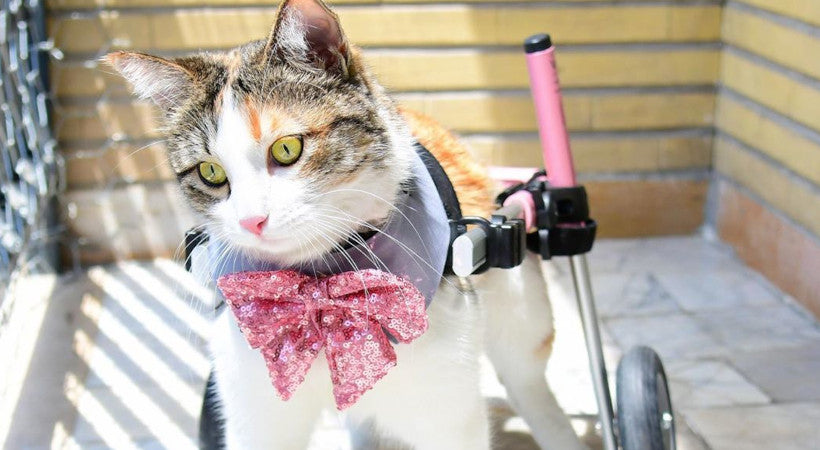Sit Down Dog Wheelchairs

Cerebellar Hypoplasia in Cats
Cerebellar Hypoplasia is a condition where a pet's brain doesn't properly develop. The cerebellar controls motor function including balance and coordination. Although more widely known as a mobility condition impacting dogs, feline cerebellar hypoplasia leaves CH cats struggling to stand, walk and difficulty controlling their movements.
Cats with cerebellar hypoplasia are not in any pain, have a normal life expectancy. Although their mobility is generally impacted, with assistance a cat with CH can go on to live a normal, happy life.
What Causes Cerebellar Hypoplasia in Cats?

Most commonly, CH begins in utero, usually when the expectant mother becomes infected with feline panleukopenia virus (or feline distemper) and passes the condition on to her unborn kittens. Trauma is another cause of the condition, typically blunt force head trauma as the kitten's brain is still developing.
To prevent the likelihood of her future kittens developing cerebellar hypoplasia, female cats should be vaccinated against distemper prior to pregnancy.
CH is not contagious and can not be passed on to another animal or kitten in the same litter.
Symptoms of Feline Cerebellar Hypoplasia
It may take awhile for a kitten to show signs of cerebellar hypoplasia, at least until they begin to walk and play. Symptoms of CH in cats include:

- Unsteady and jerky gait
- Sudden loss of balance
- Uncoordinated movements
- Tremors and uncontrolled shaking
- Standing with splayed legs
- Marching or lifting their legs high when walking
Also known as Wobbly Cat Syndrome, the most telling symptom are the uncontrolled movements and wobbly steps. Cerebellar Hypoplasia is not the only reason why a kitten may lose their balance or have difficulty standing. Balance and sensory issues could be caused by injury or other disease, for proper care and diagnosis cats showing any of the above signs should immediately be seen by a pet professional. Proper diagnosis may require a CT scan or MRI.
Levels of CH Severity in Cats
There are varying degrees of severity and impact that cerebellar hypoplasia can have on a cat's life.
Mild - Cat's at this stage experience very little impact on their life. The may experience occasional loss of balance, an uneven gait and may have minor tremors.
Moderate - can move around on their own, but cats may appear disoriented or distracted in their movements. Cats with moderate CH symptoms will splay their legs and experience frequent balance loss. They may be able to walk on their own occasionally, but most often they will need to be supported to walk.
Severe -cats with severe CH symptoms require special care and assistance to stand and walk. Head tremors are constant and tend to flop or fall over when not using a wheelchair.
Treating Cerebellar Hypoplasia

Although there is no cure for CH, there are many ways that you can improve the life of a cerebellar hypoplasia cat.
Very often, kittens with CH are euthanized due to people's misunderstanding of the condition itself. These cats are not in pain and there is no reason that these cats can't live a normal, happy life. They have a normal life expectancy same as any other "healthy" cat, they just require a little extra help and support from the people around them.
Feline Rehabilitation Therapy
It's important to know that the disease is not progressive and the symptoms will never worsen. But with patience, and rehab exercises your cat can gain strength and improve their coordination.
Cat Mobility Aids
Cat Wheelchairs
To keep CH pets active and mobile, a cat wheelchair can support them and keep them on their feet. Many cats and dogs with cerebellar hypoplasia need the support provided by a 4-wheel wheelchair that supports both their front and back legs. The wheelchair keeps them upright and balanced as the walk, run and play.
Lifting Harnesses for Cats
A lifting harness can be beneficial for milder cases and cats that can walk on their own, but need occasional assistance. A rear harness offers hind leg support and is perfect for quick trips outside and is very comfortable for cats to wear.
Caring for a Cerebellar Hypoplasia Cat
Other than a little extra care caring for a cat with cerebellar hypoplasia is no different than any other kitten. CH cats should have no problem using a litter box, going to the bathroom or eating.








